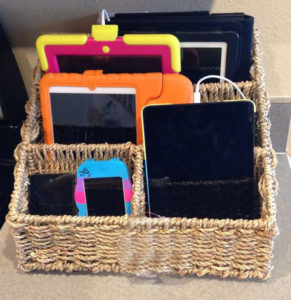6 Ways to Get a Handle on Screen Time
Last week I talked about the battle to limit the amount of time our kids are on their devices, and some of the reasons we need boundaries. There are plenty of times it seems a hopeless, never ending battle, but it’s one we need to win.
I have a few ideas to help you and the kids cut back on technology and discover there’s more life out there when they do.

Set a good example- Screen time limits are for mom and dad too. Kids need to see life without phones, tablets or computers is possible and can even be fun, and if mom and dad think so, they will too. When we, the parents, turn our tech off, we’re less distracted and pay lots more attention to our kids. Hit the off button and make plans to do something together in place of screen time. Doing something as a family will help everyone transition to life with less tech. Play cards. Read books. Do puzzles. When the tech is off, there are so many ways to spend real time together.
Get the kids on board- Call a family meeting to discuss the new guidelines for screen time. Talk about how using screens affects our bodies and the way we feel and act. Always wanting to be gaming, watching videos or texting can limit the number of things we do and are interested in. Ask your kids what time of day they want their tech most. Then work together to create a schedule that balances what they want, and the limits you know they need. Once the plan is clear, write it down and post it somewhere everyone can see.
Set specific times of day- One thing that has worked very well at my house is to set a specific time block during the day that screen usage is okay. In our house it’s NEVER before school. That’s a time we need for getting ready to be part of a group, focus and learn. Screen time does just the opposite. Maybe screen time works better for your family in the afternoon, AFTER homework is done, and before dinner. Maybe a short time after dinner and dishes are done, but a short session. Kids need at least an hour of downtime before bedtime, to unwind and quiet the mind in preparation for bedtime. If there’s a family or school activity, don’t adjust the schedule to accommodate screen time. If you’re busy during open screen time, it’s ok. You’ll all survive a day without.
Teach them to self-regulate- Talk with kids about how they feel when they’re watching videos or playing video games. If they have a hard time noticing it or describing it, tell them how you feel when you’re using it, or tell them what you notice about their behavior, when they finish. Once they become more aware of how it’s making them feel, encourage them to choose a different activity. Be kind, positive when you start doing this. No name calling, or negative, harsh comments based on your frustration. Just say what you notice in a way they can consider and direct them to different activity. Let’s be realistic, this is not going to be easy. So get your grown-up panties on and do what it takes. This is a big deal.
Talk about brain food and junk food- Not all technology is bad butfor kids it can be hard to distinguish what’s good and what’s not so good. This is a great article about categorizing their apps and games into brain food and junk food. Have them sort their apps into folders, brain food like math and reading apps or junk food like Angry Birds. Both have a time and place, but they should be spending more time on the brain food apps and less on the junk food.

There will be resistance from all parties. Behavior changes take an average of 66 days to become habit. So, consistency is going to be key in implementing these new rules. Give yourself a little grace and keep moving toward the goal.










